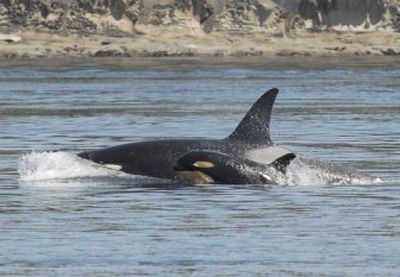Puget Sound orcas spotted with two babies

SEATTLE – Back from their winter travels, two pods of endangered orcas have been spotted swimming around the San Juan Islands with babies in tow.
Experts have estimated that K pod’s baby is only a few weeks old, while saying the L pod’s youngest member was probably born in the spring.
Both appear to be healthy, said Kenneth Balcomb, director of the Friday Harbor-based Center for Whale Research.
“They look healthy. They apparently had a good winter. It looks like they all pulled through,” said Balcolm, who confirmed the sightings Friday.
The “southern resident” population of orcas in Puget Sound – believed to have numbered 140 or more in the past century – has suffered several major periods of decline since the 1960s, when the whales were caught for aquariums. The population rebounded to 97 in the 1990s, then declined to 79 in 2001. There are 89 whales today.
The animals were listed as endangered under the federal Endangered Species Act last year, and the National Marine Fisheries Service is in the process of working up a recovery plan for them.
This month, the fisheries service proposed designating nearly all of northwest Washington’s inland waters – about 2,500 square miles – as critical habitat for killer whales, the first major development since the creatures were listed as endangered.
Projects proposed for the designated area, such as building a dock or bridge, would need to be reviewed for their effect on orcas if federal funds were involved.
At birth, orcas are 7 to 8 feet long and weigh 300 to 400 pounds. The characteristic patches around their eyes can be a bit orange at first, before fading to white.
More babies could arrive this summer. Some years have brought as many as seven calves. Two calves is considered average.
Orcas are at the top of the marine food chain and have large, complex brains. The Puget Sound orcas have a unique greeting ceremony, and the matrilineal pods have languages all their own.
“These are wonderful creatures to have in our neighborhood,” Balcomb said. “It is really important that we have animals that keep on reproducing. This is the generation that is going to make the recovery, if it is going to happen.”